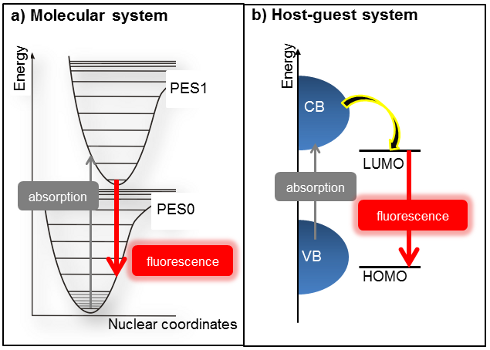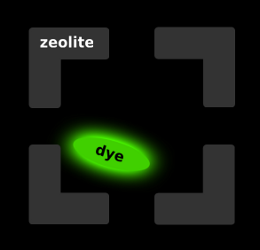Simulating Fluorescence Spectra Of Large Dyes In A Nanoporous Environment
Simulating Fluorescence Spectra Of Large Dyes In A Nanoporous Environment
Promotor(en): K. Hemelsoet /15_SPEC03 / SpectroscopySpectroscopy encompasses a variety of techniques describing interactions between radiation and matter. Depending on the type of information one is interested in, interactions with different radiation sources can be studied. In this master thesis, we focus on UV-Vis absorption and fluorescence spectroscopy involving light in the UV (190-380 nm) or visual (380-750 nm) range, leading to electronic transitions between a ground and excited state surface (see Figure 1). These transitions are relevant for large conjugated systems, such as large organic dyes which are the foreseen applications in this master thesis. These compounds will be included in a host material, and the aim is to investigate such host-guest systems using advanced ab initio simulations.

Figure 1. Energy diagram of a molecular (a) and host-guest (b) system; the ground and first excited state are depicted. Electronic transitions are indicated: absorption in grey and fluorescence in red.Traditional density functional theory (DFT) – featuring the ground state electron density as its basic variable - cannot predict the excited state properties, since it is inherently a ground-state theory. The extension towards a time-dependent variant (TD-DFT), however, allows theoretically to predict the excited states and its properties of systems where post-Hartree-Fock and advanced many-particle methods are computationally too complex. Especially the linear response formulation of TD-DFT, leading to the Casida equations, has been very successful. They allow finding the resonances of the electronic system and hence the possible electronic transitions needed to describe UV-Vis absorption and fluorescence.
To date, fluorescence spectra (involving transitions from the excited to the ground state, see Figure 1) can be computed for molecules in gas phase or in a solvent environment (Figure 1a). However, this is not straightforward for molecules occluded in more complex environments (Figure 1b), such as nanoporous materials. These materials are periodic structures consisting of pores and/or channels. Large fluorescent dyes can be used as probes to reveal information on the inner part of porous materials and to indicate the sites where reactions can occur. Figure 2 schematically depicts a fluorescent dye occluded in a porous material.
Accurate simulation of the fluorescence spectra is very challenging and requires good insight in: (1) the theoretical method used to model the electronic excited states, (2) the electronic structure of the compound and (3) the influence of a nanoporous environment on the optical spectra. In this master thesis, density functional theory, and in particular its time dependent (TD-DFT) variant will be employed.

Figure 2. Schematic representation of a fluorescent dye occluded in a nanoporous zeolite material.Aim The aim of this master thesis is to apply and/or develop theoretical tools that can compute fluorescence spectra of dyes occluded in periodic materials. We will focus on ab initio techniques, and in particular on TD-DFT, to compute directly the electronic transitions and intensities. The main challenge is to include the nanoporous environment in the simulations. This will be achieved via embedding techniques using clusters, or via periodic simulations, requiring new implementations in the theoretical codes. Initial simulations will be performed on molecular model systems, focusing on the influence of temperature on the spectra. Incorporation of the nanoporous environment in the simulations forms the main objective of this thesis.
The main challenge of this master thesis is the combination of understanding the advanced theory for the electronic structure with computations on realistic systems. The intended simulations will be performed in the software packages Gaussian and CP2K and the interested student will need to get familiar with it. This topic contributes to current research activities at the Center for Molecular Modeling and intensive coaching will be provided. The interested student can focus on particular items of this thesis research, depending on his/her specific interests.
This thesis ensures that the interested student gains a profound insight in advanced molecular modeling techniques and in the processes responsible for the optical activity of realistic systems.
This topic relates to courses in the clusters: 1) Modelling, (2) Nano and (3) Fundamentals
- Study programmeMaster of Science in Engineering Physics [EMPHYS], Master of Science in Physics and Astronomy [CMFYST]ClustersFor Engineering Physics students, this thesis is closely related to the cluster(s) 1) Modeling, (2) Nano, (3) FundamentalsKeywordsSpectroscopy, Molecular modeling, Optical propertiesRecommended coursesSimulations and modeling for the nanoscale; Veeldeeltjesfysica


